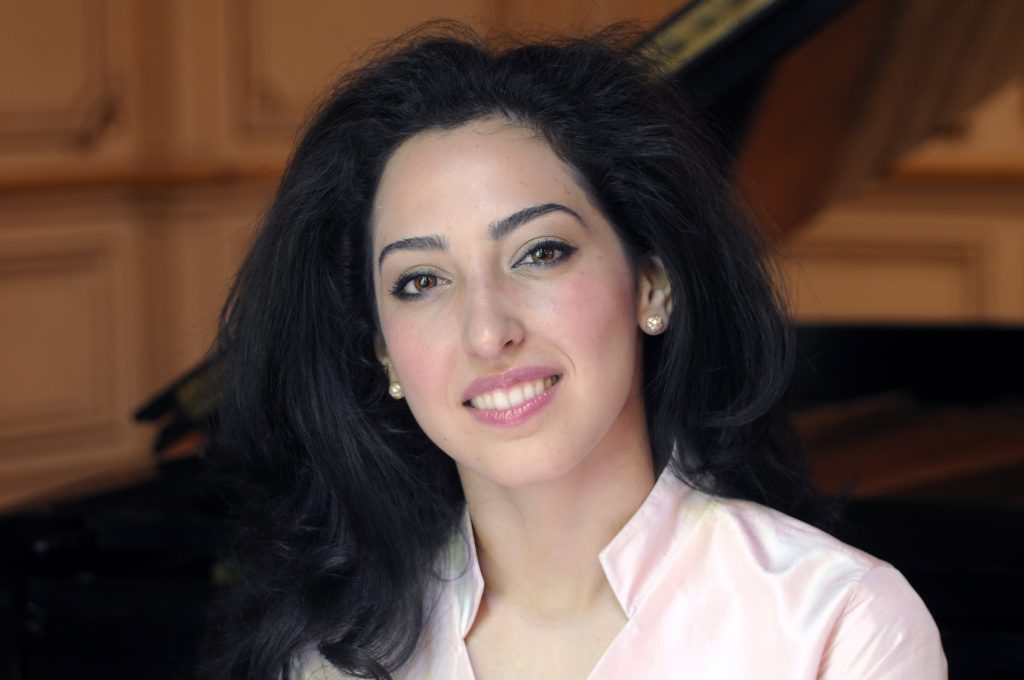
By Dennis D. Rooney
A Washington, D.C., native, pianist Sara Daneshpour has studied with Leon Fleisher at Philadelphia’s Curtis Institute, Yoheved Kaplinsky at New York’s Juilliard School, Oleg Volkov, and at present is studying with Sergei Babayan at the Cleveland Institute.
Her recital March 22 at the Steinway Gallery Boca Raton, sponsored by Piano Lovers of South Florida embraced a diverse repertoire and demonstrated why she has been a prizewinner is many competitions over the past decade. Her sound is big, confidently produced, and has sensitivity to color.
Divided into four sections, the program opened with two works of J.S. Bach: The Prelude and Fugue in G minor (BWV 885) the 16th of the 24 pairs of pieces from Book II of The Well-Tempered Clavier, followed by two portions of Die Kunst der Fuge (BWV 1080): Canon No. 1, and Contrapunctus IV, a four-voice fugue. Her performances emphasized line over color, although the canon and fugue from the unfinished Kunst der Fuge employed some attractive mezzotints.
Next came a concert suite from Tchaikovsky’s score for the ballet The Sleeping Beauty. The Russian pianist and conductor Mikhail Pletnev transcribed 12 excerpts from the ballet in 1999. Daneshpour played five, and her selection displayed impressive fluency and articulation. Pletnev seems to have taken his point of departure from the composer’s own piano reduction of the score, so the transcription is truer to the original than many similar pianistic excursions.
The program’s third section was a miscellany, led off by Mozart’s Piano Sonata No. 15 (K. 533), which dates from 1788 — at least the first two movements do. The concluding Allegretto was originally written in 1786 as a stand-alone piece but was grafted onto the sonata’s first two movements. Mozart enlarged the movement with a cadenza.
Daneshpour’s approach seemed rather soft-focus. The opening Allegro was not as propulsive as the music suggests. She brought her most imaginative playing to the central Andante, which she colored attractively, but her interpretative approach often lacked spine.
Two works of Chopin followed. The Barcarolle (Op. 60) is a relatively late work and considered one of his more difficult. The Étude in F, nicknamed “Sunshine,” is the eighth of the dozen such works in the composer’s Op. 10. Rhythmic structure in them both was weak, making the performances unpersuasive, often clattery and incoherent.
However, the concert etude Gnomenreigen (S. 145, No. 2), by Franz Liszt, was a complete success, sparkling and engaged from first to last note. She concluded the section with Rachmaninov’s Étude-Tableau in C minor (Op. 39, No. 1). The right hand was consistently obscured and the entire performance was as bereft of rhythmic structure as her Chopin with a consistent absence of breathing space.
That quality was a particular feature of the program’s concluding work, Prokofiev’s Sonata No. 8. The third and last of his so-called “War Sonatas” was first performed by Emil Gilels in 1944. It is the largest in scale of the composer’s piano sonatas, with a quasi-symphonic dimension. Lyricism, sadness, poignancy are everywhere punctuated by some violent episodes.
As in the Rachmaninov, Daneshpour moved ahead purposefully but the phrases were shorn of eloquence and mystery in favor of a relentless driving forward. One suspected the performance would have been more successful in a larger room than the Steinway Piano Gallery, where a Steinway D in a room full of people too often becomes tonally overpowering.